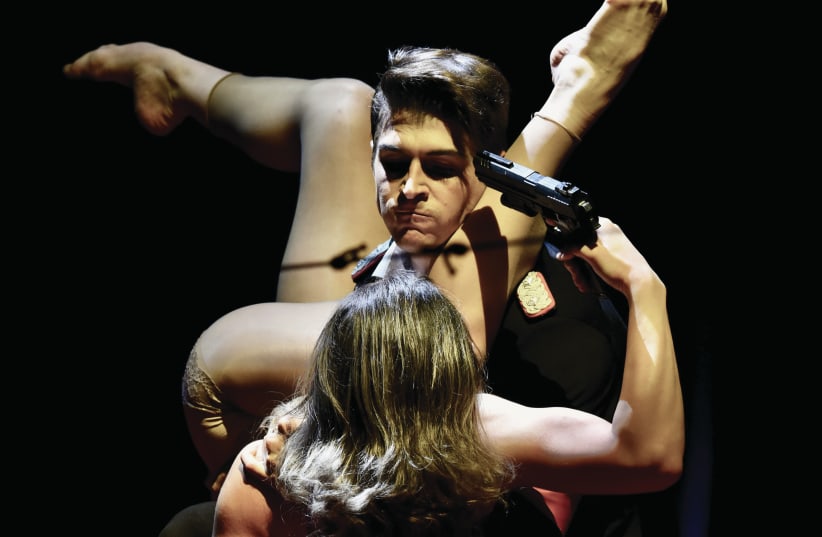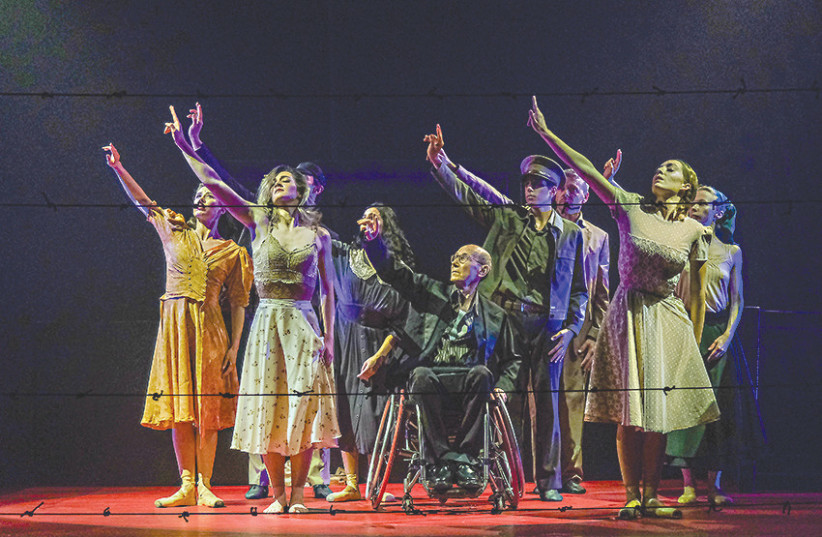When it comes to depicting the horrors of the Holocaust, Memento is one of the most dramatic and riveting ballets ever performed on stage.
The commonly heard phrase that during the Holocaust Jews went to their death “like sheep to the slaughter” is not accurate. Heroic acts of resistance, both physical and spiritual, were common during the Holocaust. Despite the dehumanization and degradation, there were many brave souls who risked their lives in order to take a stance against the Nazis.
The story of a famous Jewish ballerina
Memento is a historically based fictional ballet inspired by the heroic tragedy of a Jewish ballerina, Franceska Manheimer-Rosenberg, a famous dancer in pre-war Poland, known by her stage name, Franceska Mann.
Mann was one of the most graceful and energetic dancers of her time. She was also one of the most stunning beauties in the world of ballet. In 1939, she won fourth place in an international dance competition in Brussels, among 125 young professional ballet dancers. She was considered to be one of the most promising dancers of her generation in Poland, in both the classical and modern repertoire.
At the beginning of WW II, during the Nazi occupation of Poland, Mann was a performer at the Melody Palace nightclub in Warsaw. Everything came to a crashing halt the moment she was captured and forced into the Warsaw Ghetto. Then, on October 23, 1943, some 1,700 Polish Jews were rounded up from the ghetto and told that they were being taken to Switzerland to be exchanged for German POWs. But they were lied to, and instead were taken on passenger trains to Poland to the notorious death camp of Auschwitz-Birkenau. Mann was on this transport.
The new arrivals were told that they had to be disinfected before crossing the border into Switzerland. They were then taken into a room next to the gas chamber (disguised as a shower room) and ordered to undress.
IT WAS confirmed that Mann fatally wounded the roll call officer Oberscharführer Josef Schillinger. Using his pistol, she fired two shots, wounding him in the stomach. Then she fired a third shot that wounded another SS sergeant named Emmerich. Many accounts say that she used her seductive dancing to distract the Nazis and get hold of the gun to shoot them with.
One of the most popular, but unverified, versions of the story is that Mann is said to have performed a striptease for the Nazis at the camp and, once down to nothing but her high heels, she took one of her shoes and stabbed Walter Quakernack in the face with the heel, causing him to drop his gun. Mann then used that gun to shoot Schillinger and Emmerich. Schillinger died from his wounds several hours later, while Emmerich was left with a permanent limp.
Memento brings Franceska Mann’s story to life through ballet. Not only is the story of Mann’s courageous sacrifice inspirational to watch, but it is truly a one-of-a-kind performance that portrays the Holocaust through the prism of ballet.
The lighting in this production is creative in the extreme. The scenes that require a searchlight send shivers down one’s spine, as the searchlight is pointed not only toward the dancers on stage but also at the audience, in an interactive experience that is a tiny taste of what it must have been like to be hunted by Nazis.
The music in Memento is a combination of masterworks from collections around the world. Special mention goes to the famous Argentinean tango song “Por Una Cabeza,” along with Maurice Ravel’s masterpiece Bolero. Originally, Bolero was commissioned by dancer Ida Rubenstein, whose ballet troupe first danced it in 1928 at the Paris Opera.
Memento’s stage sets eerily transport us back to the 1940s. When the Jews are brought into the camps, we see the barbed wires rise from the floor so strategically that those in the audience are unaware that they too are facing the wire – as if trapped on the other side of the tragedy.
Instead of the renowned Argentinean ballet dancer Jorge Donn displaying his skills in his classic performance of what has become known as “Bolero de Ravel,” in this new ballet it is the main Nazi character, an SS Officer played by Michael Botzok, for whom a similar performance is choreographed. The shock factor is introduced while he is dancing on top of a chair as the song slowly begins to mesh with Hitler’s infamous, hysterical speeches given during the rise of the Third Reich.
This creative compilation of dances leaves the audience bowled over. Not only are the dancers well-trained professionals, but the fact that they are able to dance on such a small surface as a chair is mesmerizing. As Mann (Anael Zateikin) is forced by the Nazi guards to dance on a small table, each spin and twirl leaves the audience holding their collective breath. A single slip could lead to a serious fall. Zateikin’s gift as a dancer belies belief.
In a bold move, a female corps de ballet portrays the evil Nazi guards. They are wonderful dancers and spectacular actors.
Martin Schoenberg, a new oleh (Immigrant) from South Africa, is the associative director who worked hard behind the scenes with the entire cast, especially the female Nazi guards. When asked what was one of the biggest challenges he faced during the production he responded, “Getting these young adult Israeli girls, some of which are still in school, to transform themselves on stage and become these diabolical Nazis is a long process because they are sweet to work with, so it’s a challenge to mold them into such evil beings on stage.”
Adam Greenfeld steals the show in the role of Mann’s father. Greenfeld dances in his wheelchair throughout the show; his movements and skills as a dancer are formidable. His appearance in a wheelchair is symbolic of another level of evil Nazi persecution aimed at those who are differently-abled.
IN REAL life, Greenfeld is paralyzed from the waist down and is the son of Holocaust survivors. His father was a Death March survivor and had family who perished in Auschwitz. Even without knowing Greenfeld’s personal life story, his performance is emotional and compelling.
Nadia Timofeyeva, the artistic director of the Jerusalem Ballet since 2007, has created a true masterpiece in Memento. A graduate of the Academy of Choreography in Moscow, she launched her professional career at the Kremlin Theatre. However, instead of continuing on the road to success in the former Soviet Union, she and her mother Nina Timofeyeva – the former prima ballerina of the Bolshoi Ballet – decided to immigrate to Israel together. Upon relocating, mother and daughter both taught at the Academy of Music and Dance in Jerusalem.
In 2014, Timofeyeva won the Aliyah and Absorption Ministry’s Yuri Stern Prize granted to immigrant artists for special contributions to Israeli society and culture. She created this ballet that is truly unique. By combining history, dance, art, and the Holocaust, this mix is unlike anything I have ever seen.
The grand finale is a moving and powerful end to the ballet. When Mann and the Nazi SS officer have their last dance, one could say it’s a dance with the devil. The powerful scenes of the seductive dance that Mann performs lead her to the climactic point of reaching for the gun and shooting the Nazi SS officer in an intense final embrace, with the gun pointed directly at his head.
Once the shot is fired, the lights fade, and then we see how the dancers all come together for “Hatikvah,” a symbol of the rise of the Jewish people from the ashes of the crematoriums to the birth of the State of Israel – where this ballet performance takes place ❖
Upcoming performances: Oct. 19, 7:30 p.m. in Maalot, for information: (04) 957-3050; and Oct. 30 in Ma’aleh Adumim.













